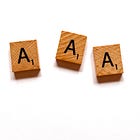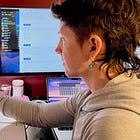Six things I learned by being a student again
Being a student again is helping me be a better educator
During the 2024-2025 academic year, I took a “sabbatical” from teaching to focus on getting started writing a new General Biology textbook for majors. With my extra time, I enrolled as a student in a conceptual physics class at the community college where I normally teach biology. I wanted to re-experience what it’s like to be a novice in an introductory science course, because I think doing so will help me become a better educator and textbook author. Since I’ve never taken physics1, it was a course that let me be a novice science learner again.
As the semester progressed, I wrote here on my Substack about my experiences as an educator-turned-student. In today’s post, I summarize the lessons I learned over the semester.
1. Different students are successful in different ways. The grading structure should support that.
I just got my final grade in my physics course: I earned a B.
This is interesting because I performed very well on every exam (my lowest exam score was 96/100). So how did I receive a B? Because I barely did any of the homework.
I could care less about my grade in this course — I took the course to learn (both about physics and about teaching & learning), not to earn course credit — but I think it’s interesting that despite demonstrating mastery of the content on all of the assessments, I earned a lower grade because I didn’t jump through the behavioral hoops of doing the homework.
I recognize that I, a PhD scientist, am not like most students. Most students who skip the homework don’t do well on the assessments. But some students do. Every semester I have one or two students who can skip the homework and do well on assessments. Some students are the opposite: they do well on the homework, but balk under the pressure of an exam. In other words, different students are different, and I think our grading structures should let different types of students earn their best grade in the way that works best for them. That’s why I use Multiple Grading Schemes.2
2. To learn, it helps to know what learning feels like
Being a student again highlighted for me what learning feels like. I noticed that the first time my physics instructor presented a topic, it seemed straightforward when she explained it, but the concept felt like a slippery fish when I tried to explain it to others. That “slippery” feeling was key to my knowing what I understood, and what I didn’t! Because of my academic background, I knew how to 1) recognize the feeling of not understanding and 2) self-direct to behaviors that helped me get closer to understanding. Not all students have those metacognition-related skills, but they are teachable.
3. Be careful using jargon and language that implies prior knowledge
A couple times during the semester my physics instructor used the words “clearly” and “remember” for concepts that were new or, well, not clear. These slip-ups had the effect of making me feel like I should know something I didn’t, and that it was somehow my fault. The same feeling can come from the instructor using jargon without defining it. In other words, it’s good practice for the instructor to be aware of the audience (what students are reasonably expected to know or not know) and tailor their language accordingly.
4. When using active learning activities in the classroom, social interactions and thinking take time
My physics instructor interspersed lecture with Think-Pair-Share questions, which are a common way to engage students in active learning3. The instructor posed a question to the class, waited for students to think about it, (sometimes) gave us time to talk to a neighbor about it, and then asked for one or two pairs of students to share their answer with the class. As an instructor, I use think-pair-share activities all the time; it was super useful to be on the receiving end of the activity because I learned that it takes time to engage my thinking brain to work on a problem, and it takes time to pair up with the stranger sitting next to me to discuss it. This has practical implications for how to efficiently implement active learning activities in the classroom.
5. Effective and equitable teaching takes instructor time, which is not free
After our first exam, my physics instructor said she would normally offer a “points-back” assignment, but since the class was too big and she didn’t have time to grade it all, she couldn’t offer it. But a “points-back” assignment is a perfect opportunity for students to learn from their mistakes — an important part of the learning process, and one that has been shown to improve learning and have more equitable outcomes when instituted in science classrooms4. Because my instructor was an underpaid adjunct, she didn’t have the time to grade exam revisions. Thus, effective and equitable education hinges on institutions supporting instructors so they can spend the time it takes to teach effectively and equitably.
6. Instructors can implement systems that deliberately support absent students
I missed class a few times during my semester-long physics class. Catching up on the material I missed helped me think more deeply about structures that instructors can implement to support students who miss class. Many of these structures require only a minimum of instructor effort but can have a large impact on helping students make up what they missed.
Header photo by Kai Rohweder on Unsplash
Not everything you read on the internet was written by a human. For full transparency, here is how I used AI to help me write this post:
I did not use AI to help me in any way to write this post.
Despite having a PhD in genetics, I never took physics - not in high school, not in college (where I had to take either physics or statistics for my biology major), and not in grad school.
The irony is that the physics course I was enrolled in also uses Multiple Grading Schemes, but in the most homework-light scheme, homework still counts for 15% of the final grade. Hence, by not doing most of the homeworks, I automatically couldn’t get higher than a B.
Think-Pair-Share is one of myriad activities to engage students in Active Learning, an approach that has been shown to increase student performance and increase equity in Science, Technology, Engineering, and Math (STEM) classrooms. By incorporating Active Learning activities in a lecture-based course, students get to practice the hard work that builds learning (recalling concepts, solving problems, making connections, etc) while getting immediate class-wide feedback from the instructor.
See for example:
D. J. Webb, C. A. Paul, Attributing equity gaps to course structure in introductory physics. Phys. Rev. Phys. Educ. Res. 19, 020126 (2023). https://doi.org/10.1103/PhysRevPhysEducRes.19.020126
V. S. Vyas, S. A. Reid, What Moves the Needle on DFW Rates and Student Success in General Chemistry? A Quarter-Century Perspective. J. Chem. Educ. 100, 1547–1556 (2023). https://doi.org/10.1021/acs.jchemed.2c01121









Terrific recap! And nice job throughout in noting issues with how this instructor was teaching you without making it a mean-spirited blame game.
I would note that homework in chemistry and physics is an assessment. There is not enough time and room in exams to touch on all the things that need to be assessed. By not doing the homework there are things you may not have learned.
Possibly in an intro course this isn't apparent, but in my upper level courses the homework has problems that go much deeper than one can do in an in-class exam. Sometimes I address this with take-home exams.